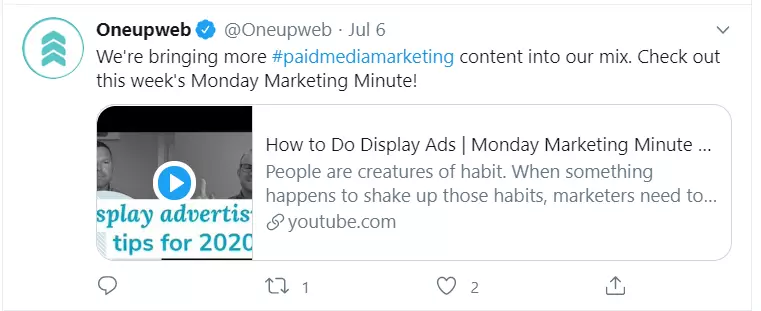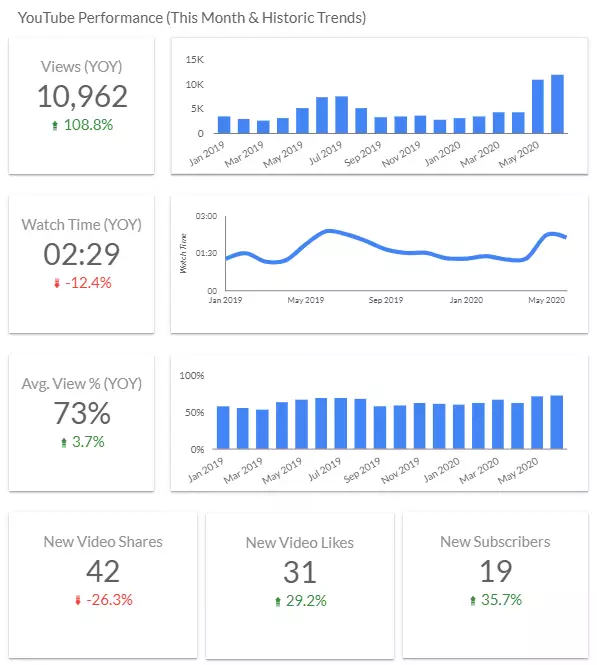How to Determine KPIs for Marketing and Sales Goals
Goals establish a destination. KPIs, or key performance indicators, measure how far you’ve gone and how quickly you’re covering the ground on the way there.
Setting and monitoring specific metrics (KPIs) can lead to improved efficiency and drive real-world results in marketing, sales and life.
Learn how to establish KPIs based on your goals, tips for measurement and see examples of channel-specific KPIs.
First, What’s a KPI?
KPIs, or key performance indicators, are specific metrics used to benchmark progress toward a specific goal. In digital marketing, there are hundreds of different KPIs that can be measured. Choosing the right KPI for your goal is critical to capturing and reporting on meaningful data.
Metric vs. KPI
A KPI is a metric, but not all metrics are key performance indicators. Many metrics, such as total website sessions or SERP impressions, have a relatively small impact on business success. Choosing a few key metrics allows marketing and sales teams to focus on measurable data that has the biggest impact on reaching the company’s goals.
How to Identify KPIs for Your Brand
Determining unique key performance indicators (KPIs) is essential for marketing and sales teams. Without specific metrics, there’s no standard for measuring company growth.
To identify the best KPIs for your business, answer these six questions:
- What are your company-wide, time-bound business goals?
- Do departmental goals support overall goals?
- Which data source(s) is your source of truth?
- What actions are you currently tracking – and not tracking – that are important to your business?
- Should you be measuring progress in all parts of the marketing/sales funnel?
- Should your KPIs be specific to a geographic location?
Growth rarely happens overnight. It’s important to establish long- and short-term KPIs to measure success over time.
Examples of common KPIs:
| Short-term KPIs | Long-term KPIs |
| Conversion rate Cost per lead Daily active users (DAU) Email subscribers Social media followers | Annual revenue Customer Lifetime Value (CLV) Market share |
You’re well on your way to measuring progress more accurately. Let’s examine some examples of KPIs in marketing and sales.
5 Common Key Performance Indicators
These are extremely common marketing and sales KPI examples:
- Sales revenue
- Cost per lead
- Sessions or pageviews (by channel)
- Website conversions (by channel)
- Inbound marketing ROI (return on investment)
Of course, there are hundreds of potentially valuable KPIs. Some will be more valuable to your brand than others.
Some key performance indicators may be referred to as “leading KPIs,” which show trends implying future performance. Some are considered “lagging KPIs,” which measure performance already achieved. Both can be valuable depending on your organization’s goals!
KPIs also vary by marketing channel. The more your company depends on a specific tactic, like paid media or email marketing, the closer you’ll monitor specific metrics within that channel.
Here’s how to determine your KPI within specific digital marketing channels …
Examples of KPIs by Channel
While having a few simple, overarching KPIs for sales and marketing is good, specificity is often more valuable. For example, at Oneupweb, we find it helpful to identify KPIs for the central goal and metrics to measure micro goals we’ll achieve along the way.
The channel-specific KPI examples below are based on the session default channel groupings in Google Analytics. (See definitions here.) If you use custom channel groupings or a different analytics platform, the process of determining your KPI might vary.
Content Marketing & SEO KPI Examples
Resource content such as blogs, whitepapers and downloadable documents are great ways to attract and engage new users, as well as your existing audience. If your business is heavily invested in content marketing and SEO, you should consider these KPIs:
- Conversions (sales form, call, etc.)
- Conversion rate
- Leads (newsletter signup, resource download, event registration, etc.)
- Organic search sessions
- Organic search engagement (bounce rate, time on page, pages per session, scroll depth, etc.)
- Inbound link clicks
- Backlinks – Learn our favorite link building strategies.
- Keyword metrics (# of keywords, featured snippets, average position, impressions, etc.)
- Return on SEO investment – See how we calculate SEO ROI.
- Social media referrals to resource content
You may also establish different KPIs for content categories within your site. For example, we expect different engagement rates for blog and service content. To establish KPIs for these content segments, we use historical data and our knowledge of users at various stages of the sales funnel.
Paid Advertising KPI Examples
Paid media KPIs typically focus on audience awareness, consideration and conversion. Here are some of the best KPIs to track for paid advertising:
- Impressions and impression share
- Clicks and CTR (clickthrough rate)
- Conversions (sales form, call, etc.)
- Conversion rate
- ROAS (return on ad spend)
- CPA (cost per acquisition)
- Quality score – either internally calculated or generated by Google
Email Marketing KPI Examples
To determine how your email marketing strategy is performing, we recommend tracking these KPIs:
- Deliverability rate
- Opens and open rate
- Clickthrough rate
- Email referral sessions
- Unsubscribe rate
- Conversions
Social Media Marketing KPI Examples
Social media marketing KPIs may resemble your paid advertising KPIs, with the addition of engagement and reach metrics. Here are top social media marketing KPIs to track:
- Engagement – especially likes, comments, shares and mentions
- Followers
- Impressions
- Social media website sessions
- Leads
- Conversions
- Lead-to-conversion rate
- Cost per lead
- Revenue

SproutSocial has further social media KPIs organized in categories.
YouTube KPI Examples
As YouTube continues to increase in popularity, it’s becoming more important to optimize your YouTube channel and measure performance. These are common YouTube KPIs:
- Total watch time
- Average view percentage
- Likes and shares
- Views
- Subscribers
- YouTube-referred website sessions and conversions
Prioritizing These YouTube Metrics
Certain YouTube KPIs should be prioritized over others. Our agency recommends prioritizing total watch time and average view percentage (otherwise known as retention) first because these metrics provide a holistic view of your channel’s performance. Watch time also has direct impact on video rankings and monetization. Likes and shares, or video engagement metrics, are good indicators of how well a video is resonating with your audience.
Finally, YouTube-referred website sessions and conversions should be accounted for last. While sessions and conversions are good for your bottom line, they don’t necessarily benefit the performance of your channel. Like many social platforms, YouTube ranks channels that keep viewers on the YouTube domain higher than channels that lead viewers away. As marketers, this requires a delicate balancing act.
For example, here’s part of a YouTube report (in Google Looker Studio) that Oneupweb produces for a fairly recent YouTube services client:

Conversion Rate Optimization KPI Examples
CRO (conversion rate optimization) tests changes to your website to help increase the percentage of sessions that result in a conversion. Remember that conversion events may have different definitions based on your industry or business goals. After you make CRO updates, these KPIs will help you understand how the changes impacted your website:
- Conversion rate
- Engagement metrics (bounce rate, time on page, pages per session, scroll depth, etc.)
- Internal link clicks or resource downloads
- Shopping cart abandonment rate
Sales Team KPIs
Sales teams may focus on KPIs that are different from those of their marketing colleagues. This works well if they support the same overarching goal, but it’s important to cross-reference and discuss these KPIs regularly to keep both teams aligned.
Here are some common sales-team KPIs:
- Sales (total and by channel)
- Lead-to-sale rate
- Lead quality
- Number of engagements per rep
- Customer lifetime value
- Retention and churn rates
Improve Digital Marketing Reporting & Progress
Need help narrowing in on appropriate KPIs and setting up custom tracking? We’re here to help. We’ll provide easy-to-digest reports, audit your reporting platforms and handle everything you need to develop an effective marketing strategy. Call us at (231) 922-9977, or contact us to get started today!